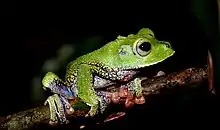| Rhacophorus georgii | |
|---|---|
 | |
| R. georgii in Indonesia | |
| Scientific classification | |
| Domain: | Eukaryota |
| Kingdom: | Animalia |
| Phylum: | Chordata |
| Class: | Amphibia |
| Order: | Anura |
| Family: | Rhacophoridae |
| Genus: | Rhacophorus |
| Species: | R. georgii |
| Binomial name | |
| Rhacophorus georgii Roux, 1904 | |
Rhacophorus georgii (common name: Tuwa flying frog) is a species of flying frog in the family Rhacophoridae endemic to Sulawesi, Indonesia.[2] Its type locality ("Tuwa, Paluthal, West-Central Celebes"[2]) cannot be located, but it has recently been collected from Buton, off southeastern Sulawesi.[1]
Rhacophorus georgii live in lowland forests, below 800 m (2,600 ft) asl. These frogs attach foamy egg masses to the trunks of trees, 1–3 cm above water-filled tree cavities; each female can carry 29–108 eggs. Upon hatching, tadpoles fall to these water-filled cavities.[1]
Specific threats to this species are unknown but it is probably negatively affected by habitat loss.[1]
References
- 1 2 3 4 IUCN SSC Amphibian Specialist Group (2020). "Rhacophorus georgii". IUCN Red List of Threatened Species. 2020: e.T58996A177129943. doi:10.2305/IUCN.UK.2020-3.RLTS.T58996A177129943.en. Retrieved 14 November 2021.
- 1 2 Frost, Darrel R. (2014). "Rhacophorus georgii Roux, 1904". Amphibian Species of the World: an Online Reference. Version 6.0. American Museum of Natural History. Retrieved 16 February 2014.
This article is issued from Wikipedia. The text is licensed under Creative Commons - Attribution - Sharealike. Additional terms may apply for the media files.
